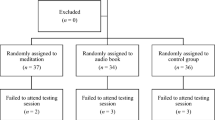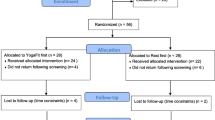Abstract
This study examined the effect of light on relaxation associated with flotation restricted environmental stimulation therapy (REST), as measured by plasma cortisol, mean arterial pressure, and psychometric parameters. Twenty-one subjects were paired by baseline cortisol levels into two groups: one experiencing flotation REST in the presence of light (REST-L) and one experiencing flotation REST in the absence of light (REST-D). Subjects were 15 male and 6 female students aged 22–28 in normal health who had not experienced REST. Repeated flotation REST (8 sessions) either with light or without light was associated with a decrease in plasma cortisol and a decrease in mean arterial pressure, with no differences in effectiveness between groups. The psychometric assessment of mood, using the POMS scale, before and after sessions 1 and 8 revealed mood state improvement in both REST-L and REST-D groups. These data suggest that the presence of light did not compromise the flotation REST experience, as evidenced by the lack of difference between REST-L and REST-D groups.
Similar content being viewed by others
References
Adams, H. B., Cooper, G. D., & Scott, J. C. (1987). REST and reduced alcohol consumption. In J. W. Turner, Jr., & T. Fine (Eds.),REST and self regulation: Proceedings of the 2nd International Conference (pp. 156–183). Toledo, OH: IRIS.
Basmajian, J. V. (1985).Biofeedback principles and practice for clinicians (2nd ed.). Baltimore: Williams & Wilkins.
Davidson, D. M., Winchester, M. A., Taylor, C. B., Alderman, E. A., & Ingles, N. B. (1979). Effects of relaxation therapy on cardiac-performance and sympathetic activity in patients with organic heart disease.Psychosomatic Medicine, 41 303–309.
Delmonte, M. M. (1984). Physiological responses during meditation and REST.Biofeedback and Self-Regulation, 9 181–200.
Fine, T. H., & Turner, J. W., Jr. (1982). The effect of brief restricted environmental stimulation therapy in the treatment of essential hypertension.Behaviour Research and Therapy, 20 567–570.
Fine, T. H., & Turner, J. W., Jr. (1985a).REST and self-regulation: Proceedings of the 1st International Conference. Toledo, OH: IRIS.
Fine, T. H., & Turner, J. W., Jr. (1985b) REST-assisted relaxation and chronic pain. In J. J. Sanchez-Sosa (Ed.),Health and clinical psychology (Vol.4, pp. 511–520). New York: Elsevier Science.
Francis, W. D., & Stanely, J. M. (1985). The effects of restricted environmental stimulation on physiological and cognitive indices. In J. W. Turner, Jr., & T. H. Fine (Eds.),REST and self-regulation: Proceedings of the 1st International Conference (pp. 40–49). Toledo, OH: IRIS.
Jacobs, G. D., Heilbronner, R. L., & Stanley, J. M. (1985). The effects of short term flotation REST on relaxation: A controlled study. In J. W. Turner, & T. H. Fine (Eds.),REST and self-regulation: Proceedings of the 1st International Conference (pp. 179–185). Toledo, OH: IRIS.
Jevning, R., Wilson, A., & Davidson, J. M. (1978). Adrenocortical activity during meditation.Hormones and Behavior, 10 54–60.
Kristeller, J., Schwartz, G. E., & Black, H. (1982). The use of restricted environmental stimulation therapy in treatment of essential hypertension: Two case studies.Behaviour Research and Therapy, 20 561–566.
McGrady, A., Turner, J. W., Jr., Fine, T. H., & Higgins, J. T. (1987). Effects of biobehaviorally-assisted relaxation training on blood pressure, plasma renin, cortisol, and aldosterone levels in borderline essential hypertension.Clinical Biofeedback and Health, 10 16–25.
McGrady, A. V., Yonker, R., Tan, S. Y., Fine, T., & Woerner, M. (1981). The effect of biofeedback-assisted relaxation training on blood pressure and selected biochemical parameters in patients with essential hypertension.Biofeedback and Self-Regulation, 6 343–353.
McNair, D., Lorr, M., & Droppleman, L. (1971).EITS manual for Profile of Mood States. San Diego: Education and Industrial Testing Service.
Michaels, R. R., Huber, M. J., & McCann, D. S. (1976). Evaluation of transcendental meditation as a method of reducing stress.Science, 192 1242–1244.
Suedfeld, P., & Baker-Brown, G. (1986). Chamber REST and aversive conditioning in smoking cessation: Active and placebo effects.Behaviour Research and Therapy, 24 421–428.
Suedfeld, P., Roy, C., & Landon, B. P. (1982). Restricted environmental stimulation therapy in the treatment of essential hypertension.Behaviour Research and Therapy, 20 567–570.
Suedfeld, P., & Schwartz, G. (1983). REST as a treatment for autistic children.Journal of Developmental and Behavioral Pediatrics, 4 196–201.
Turner, J. W., Jr., & Fine, T. H. (1983). Effects of relaxation associated with brief restricted environmental stimulation therapy (REST) on plasma cortisol, ACTH, and LH.Biofeedback and Self-Regulation, 9 115–126.
Turner, J. W., Jr., & Fine, T. H. (1985). Hormonal changes associated with restricted environmental stimulation therapy. In J. W. Turner, Jr., & T. H. Fine (Eds.),REST and self-regulation: Proceedings of the 1st International Conference (pp. 17–39). Toledo, OH: IRIS.
Wallace, R., & Benson, H. (1972). The physiology of meditation.Scientific American, 225 84–90.
Zar, J. H. (1984).Biostatistical Analysis (2nd ed.) Englewood Cliffs, N.J.: Prentice-Hall.
Zipser, R. D., Speckart, P. F., Zia, P. K., Edmiston, W. A., Lau, F. Y. K., & Horton, R. (1976). The effect of ACTH and cortisol on aldosterone and cortisol clearance and distribution in plasma and whole blood.Journal of Clinical Endocrinology and Metabolism, 43 1101–1109.
Zubek, J. B. (1969).Sensory deprivation: 15 years of research. New York: Appleton-Century-Crofts.
Author information
Authors and Affiliations
Rights and permissions
About this article
Cite this article
Turner, J.W., Fine, T., Ewy, G. et al. The presence or absence of light during flotation restricted environmental stimulation: Effects on plasma cortisol, blood pressure, and mood. Biofeedback and Self-Regulation 14, 291–300 (1989). https://doi.org/10.1007/BF00999120
Issue Date:
DOI: https://doi.org/10.1007/BF00999120




